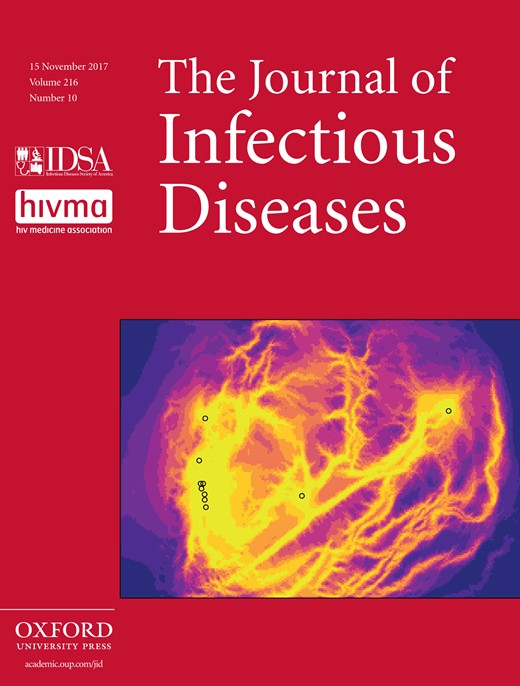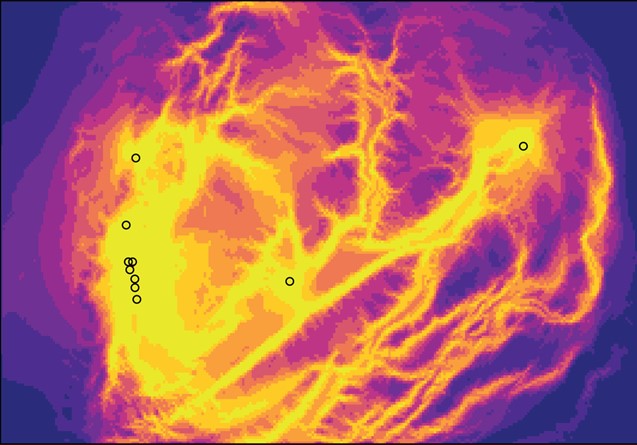
Cover image

Volume 216, Issue 10, 15 November 2017
EDITORIAL COMMENTARY
Measles Virus Is Unforgiving Where Immunity Gaps Exist
OBITUARY
In Memorium: William Ernest Dismukes 1939–2017
MAJOR ARTICLES AND BRIEF REPORTS
VIRUSES
Risk Factors for Measles Virus Infection Among Adults During a Large Outbreak in Postelimination Era in Mongolia, 2015
Mongolia experienced a large, nationwide, measles outbreak with very high incidence among young adults, despite high historical immunization coverage. A case-control outbreak investigation found that measles risk among adults was associated with hospital exposure and birth outside the capital city.
CD-loop Extension in Zika Virus Envelope Protein Key for Stability and Pathogenesis
Zika virus emergence is a major concern for public health. We find extension of a loop within the envelope protein influences stability and pathogenesis. With implications for vaccine development, this motif may distinguish stability and severity across the flavivirus family.
The Impact of Human Papillomavirus Catch-Up Vaccination in Australia: Implications for Introduction of Multiple Age Cohort Vaccination and Postvaccination Data Interpretation
Our modeling results indicate that vaccinating multiple cohorts in Australia produced markedly faster population-level direct/herd effects, compared with a counterfactual scenario of routine vaccination only, and it added benefits in the prevention of HPV-related diseases that will last for decades.
Estimating HPV DNA Deposition Between Sexual Partners Using HPV Concordance, Y Chromosome DNA Detection, and Self-reported Sexual Behaviors
Some HPV DNA detections may represent depositions from infected sexual partners rather than true infections. We used type-specific HPV concordance between sex partners and a biomarker of male cell deposition to estimate the fraction of detections attributable to recent sex.
Randomized Comparison of Immunogenicity and Safety of Quadrivalent Recombinant Versus Inactivated Influenza Vaccine in Healthy Adults 18–49 Years of Age
Randomized comparison of immunogenicity and safety of quadrivalent recombinant versus inactivated vaccine in young adults showed overall comparable antibody titers to vaccine strains, including higher responses to influenza A/H3N2 consistent with better efficacy previously reported in adults 50 or older.
Emergence of Novel Human Norovirus GII.17 Strains Correlates With Changes in Blockade Antibody Epitopes
Capsid sequence changes in norovirus GII.17 strains result in loss of blockade antibody binding, indicating that viral evolution, specifically at residues 393–396, may have contributed to the emergence of cluster IIIb strains and the persistence of GII.17 in human populations.
Supplemental Oxygen–Free Days in Hematopoietic Cell Transplant Recipients With Respiratory Syncytial Virus
Confirmation of respiratory syncytial virus (RSV) in the lower respiratory tract is associated with worse clinical outcomes, including increased supplemental oxygen use, decreased supplemental oxygen–free days, and greater mortality rate. Supplemental oxygen–free days as a clinical end point may allow smaller sample sizes for trials evaluating RSV antivirals.
Evaluating Treatment Efficacy in a Mouse Model of Enterovirus D68–Associated Paralytic Myelitis
A mouse model of enterovirus D68 (EV-D68) paralytic myelitis can be used to evaluate the efficacy of possible treatment options for EV-D68–associated central nervous system disease.
PARASITES
Frequent Spread of Plasmodium vivax Malaria Maintains High Genetic Diversity at the Myanmar-China Border, Without Distance and Landscape Barriers
Plasmodium vivax infections along the Myanmar-China border exhibited high genetic diversity but low polyclonality. Frequent parasite gene flow via human movement contributes to local and cross-border spread of malaria. It is thus important to reinforce and improve existing control efforts along border areas.
A Novel Gametocyte Biomarker for Superior Molecular Detection of the Plasmodium falciparum Infectious Reservoirs
We have identified a superior diagnostic biomarker, Pfg17, for detecting asymptomatic reservoirs otherwise missed by the most sensitive molecular method available. Gametocyte transcriptome analyses also improved the repertoire of transmission-stage antigens available for evaluation as candidate vaccines.
Metabolic Profiling of Central Nervous System Disease in Trypanosoma brucei rhodesiense Infection
1H nuclear magnetic resonance metabolic profiling of cerebrospinal fluid demonstrated that biochemical markers were associate with presentation of neurological symptoms in African trypanosomiasis, rather than disease stage. Thus, disease staging using standard diagnostic methods may not accurately mirror the invasion of the brain by parasites.
FUNGI
Aspergillus fumigatus Cell Wall α-(1,3)-Glucan Stimulates Regulatory T-Cell Polarization by Inducing PD-L1 Expression on Human Dendritic Cells
α-(1,3)-Glucan polysaccharide of Aspergillus fumigatus induces human dendritic cell maturation and stimulates regulatory T-cell (Treg) responses by the PD-L1-dependent pathway. PD-L1 inhibition significantly enhanced α-(1,3)-glucan-mediated IFN-γ secretion, indicating that the PD-1–PD-L1 pathway could be targeted to enhance protective immune responses to A. fumigatus infections.
BACTERIA
Immunoglobulin A Protease Variants Facilitate Intracellular Survival in Epithelial Cells By Nontypeable Haemophilus influenzae That Persist in the Human Respiratory Tract in Chronic Obstructive Pulmonary Disease
Nontypeable Haemophilus influenzae (NTHi) expresses 4 IgA protease variants with distinct cleavage specificities. Two IgA protease variants (B1 and B2) mediate intracellular survival in respiratory epithelial cells, indicating that IgA protease variants play distinct roles in pathogenesis.
Haemophilus Protein F Orthologs of Pathogens Infecting the Airways: Exploiting Host Laminin at Heparin-Binding Sites for Maximal Adherence to Epithelial Cells
Orthologs of the laminin-binding Haemophilus influenzae protein F were identified by in silico mining in 3 other important human pathogens that cause respiratory disease. Protein F orthologs targeted heparin-binding domains of laminin, resulting in adherence to alveolar epithelial cells.
PATHOGENESIS AND HOST RESPONSE
A Link Between a Common Mutation in CFTR and Impaired Innate and Adaptive Viral Defense
Acute respiratory virus infections often have a prolonged duration in cystic fibrosis patients and predispose the cystic fibrosis lung to bacterial colonization. An experimental enterovirus infection model couples the ΔF508-mutation in CFTR to delayed virus clearance and defective antiviral immunity.
Comparative Genomic Analysis and In Vivo Modeling of Streptococcus pneumoniae ST3081 and ST618 Isolates Reveal Key Genetic and Phenotypic Differences Contributing to Clonal Replacement of Serotype 1 in The Gambia
In this study we provide important evidence to show that changes in the epidemiology of pneumococcal serotype 1 sequence types in The Gambia may be a direct consequence of differences in virulence and increased ability to colonize hosts over time.



